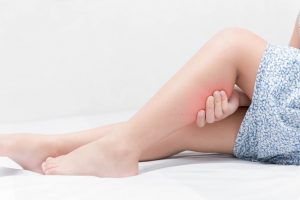 A pulled calf muscle can be very uncomfortable, but calf strain exercises can help with recovery and prevent repeated injury to the muscle.
A pulled calf muscle can be very uncomfortable, but calf strain exercises can help with recovery and prevent repeated injury to the muscle.
A pulled calf muscle or strain usually occurs in the two muscles in the lower back area of your leg. These muscles are called the gastrocnemius and the soleus muscles. When people strain their calf, muscle fibers are usually torn to a certain degree. In some cases, a partial tear can happen, while in other situations a complete tear occurs.
Advertisement
Pain, swelling, stiffness, and bruising are typical signs of a tear or strain in the calf. A lot of people get a calf strain from overextending the gastrocnemius and soleus during physical activities. Many people assume they should avoid exercise altogether when they strain their calf. The truth is, there are certain exercises for calf strain that help as opposed to hinder the condition.
Exercises and Stretches for Calf Strain
It is best to perform calf muscle strain exercises under the supervision of a physical therapist, at least when you first get started with your recovery; however, here are some common calf strain treatment exercises often endorsed by therapists and doctors.
Seated Calf Stretch
This is one of the calf strain exercises that allows for a gentle stretch of the injured muscle. It enables many sufferers to improve their range of motion. Still, it should only be performed after the acute pain has started to subside. For this exercise, sit on the floor with your injured leg out in front of you. Flex your ankle and bring the toes toward your body until you can feel a stretch through the back of your calf. Hold for five to 10 seconds and relax. You can repeat this move a few times a day.
Standing Calf Stretch
Stretching exercises for calf muscle strain, vary in intensity, and this stretch is considered more intense. This stretch should be performed after the seated stretch and only if you don’t have pain. Stand to face the wall and put your hands flat against the wall. You then step back with your injured leg and slightly bend your healthy leg. The next move is to straighten your knee and press the heel of your injured leg down as you press gently forward into your bent knee. You should feel a mild stretch in the muscle. Hold for five to 10 seconds.
Advanced Heel Lift
This can be one of the most challenging calf strain stretching exercises. It is believed to improve strength and help prevent further injuries. You stand next to a wall with the balls of your feet resting on the edge of a step or a block. Slowly lower your heels until you feel a stretch in the calves. Hold for 10 seconds and then contract the calves to lift your heels until you are up high on your toes. Pause for a brief moment then lower your heels and repeat the exercise.
Ankle Plantarflexion
For this exercise, you sit with your injured leg straight and supported on the floor while your other leg is bent with the foot flat on the floor. While keeping your injured leg straight, flex your foot down so that your toes are pointed away from your body. Relax your foot and repeat anywhere between eight to 12 times.
Ankle Dorsiflexion
This calf strain exercise requires you to sit with your affected leg straight and supported by the floor while the other leg is bent with the foot flat on the floor. Keeping your leg straight, flex your foot back so your toes point upward and then slowly relax the foot to the starting position. This exercise can be repeated eight to 12 times.
Toe Dip
The toe dip calls for a sturdy box, stair step, or curb as a prop. You stand on the edge of the prop with your toes. It is good to have something to hold onto for balance. While keeping your toes on the box or step, let your heel drop down to the ground and you should feel a stretch in the back of the leg.
Heel Cord Stretch
Advertisement
This exercise can be performed by leaning forward and grabbing your foot, or by using something to help you if you aren’t flexible enough. You can use a towel or rubber Thera-band if need be. Hold the ends of the towel or band and loop the middle around your toes. Keep your knee straight with the toes pointing up then pull the towel ends so that you are pulling your toes towards your body. This calf strain stretches the back of the leg and the bottom of the foot.
A calf strain is the type of injury that any of us can experience. It can occur during high-speed movements like jumping and running or from something as simple as an uncoordinated motion. These strains are well known among both professional and amateur athletes. According to physical therapists, as we age, the calf can become more vulnerable to strain with less forceful movement. No matter what the cause or what your age; you don’t have to suffer long-term. With the right calf exercises, you can reduce pain, as well as regain muscle strength and flexibility.
Also read:
- Muscle fatigue: Causes, symptoms, and treatment
- How to recover from muscle atrophy with diet and exercises
- Muscle knots: Causes and treatment
